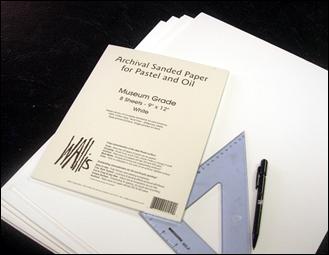 Photo 1
Photo 1
Wallis sanded paper is ready to be premounted to rag mount boards for later use.
The art of pastel is as popular as ever, with many artists selecting soft pastels as their medium of choice. Spacers, reverse bevels and sink mounts might all be elements used in framing an original pastel, as they have delicate surfaces which can smudge or dust-off. And they are never to be sprayed with fixative nor pressed against glass by any framer. That said there is much a willing framer may learn from their pastel artist client and about the handling and framing of this delicate medium.
Plan Ahead
Though a custom framer should never agree to dry, wet, or pressure-sensitive mount a finished pastel to a backing board, you may indeed dry mount raw 9x12" sheets of sanded paper—such as Wallis—to a larger backing board prior to the application of any pastel pigment (photo 1). Advertising to your local artist community the service of premounting watercolor or pastel paper to a rigid substrate prior to the application of pigment is one way to avoid the later complications of how to mount a completed original. FYI, though most special sanded pastel paper is produced as neutral and archival, it is often packaged with an acid chipboard support backing, allowing acids from the backing to be absorbed by the pastel sheets, so mounting of these papers to a high quality cotton rag board may help.
 Photo 1
Photo 1
Wallis sanded paper is ready to be premounted to rag mount boards for later use.
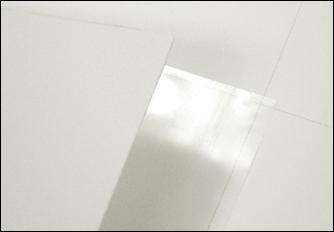 Photo 2
Photo 2
The white, raw 9x12" sanded paper will be dry mounted to rag board using film adhesive. Measure and mark the backing for easy placement. Another alternative is to premount adhesive to the back of the Wallis paper, trim, then flat mount to backing board.
Mounting Art Papers
Measure and mark the backing for easy placement. Another alternative is to premount adhesive to the back of the Wallis paper, trim, then flat mount to backing board. The white sanded paper should be dry mounted with a film adhesive to at least a 4-ply rag, though 8-ply is more rigid and therefore a better choice. Foam center board is not a good choice because it can easily dent or bend during pigment application. The sanded paper may be either premounted with film adhesive and flat mounted to the center of the substrate, or by centering the layers and mounting in one step (photo 2). The 9x12" sanded paper should be mounted to the center of a 16x20" backing to allow for 3-4" mats to be applied when framing (photo 3).
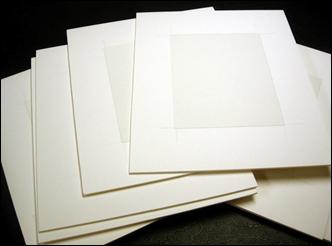 Photo 3
Photo 3
The paper should be mounted to the center of a 16x20" backing to allow for 3-4" mats to be applied when framing.
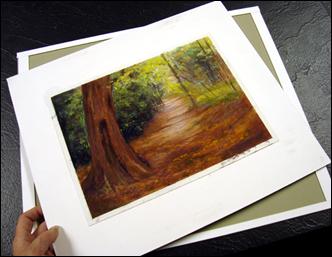 Photo 4
Photo 4
A sink mount was created to fill out the additional ½" required to expand the backing board for framing.
Sink Mounted Backing
The correct way to accommodate a pastel mounted to a substrate that is too narrow for the desired mat width is by creating a sink mount (photo 4). Cut a new 4-ply or foam backing the outside dimensions of the top mats, then using strips the same thickness of the original substrate build a simple pinwheel to fill the void (photo 5). In this sample an additional ½" of 4 ply mat board was needed to expand the substrate to support the mats. Linen tape will be used later to create a book hinge connecting the window mat unit to the sink mount backing board with its fitted pastel (photo 6).
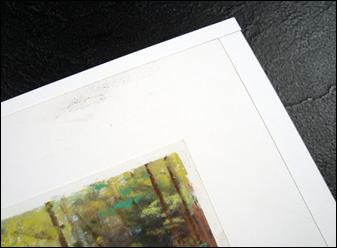 Photo 5
Photo 5
A simple pinwheel was built using the same 4-ply thickness as the original mount board making the sink mount level across the top.
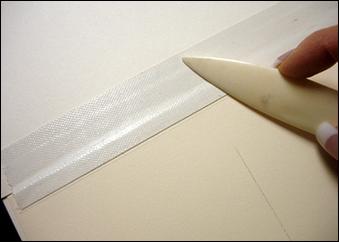 Photo 6
Photo 6
Linen tape should only be used for book hinging the mat unit to the backing board with mounted pastel, never for hinging art.
If the pastel has not be premounted to a backing it will require an alternative method of mount. Corner pockets might work but only if the sand paper is larger than the artwork. Often artists leave an exterior trim of unused paper as a buffer surrounding the image for a spacer to press against while still never coming on contact with the pastel (photo 7). If the pastel has remain unmounted and there is a clean border with no pigment then corner pockets might be an alternative mounting method. Just make certain they remain hidden behind the spacers.
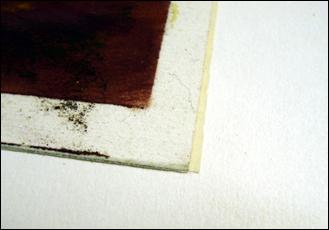 Photo 7
Photo 7
Notice the spacer surrounding the image. This sample was dry mounted prior to pigment application, but if not then corner pockets may have been used to hold it to the backing board.
Edge strips or side mounts, such as ArtSavers, are another alternative mounting method. Again make sure they do not touch the pigment and are hidden beyond the spacer
Spacers and Mat Color
The basic pastel package includes frame, UV-glass, acid neutral or buffered mat(s), spacers to keep the mats from touching the pastel, mount backing, and/or filler boards. Mats should never be allowed to touch the surface of pastel pigment and should generally be cut using a reverse bevel. The use of a 4-ply or ⅛" reverse bevel spacer attached to the back of the bottom mat lifts it away from the pastel, also allowing for dry pigment to more easily land behind the bottom mat (photo 8).
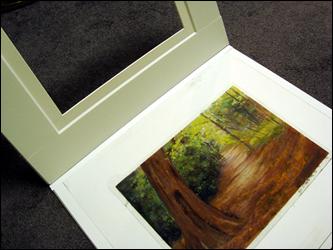 Photo 8
Photo 8
Close examination shows a ³⁄₁₆" reverse bevel spacer has been applied to the back of the hinged mat.
Vibrant mat colors may go with the décor of a home, but framing should be for the art. Mat colors for pastels should remain understated and neutral, never visually distracting the viewer. White is a popular neutral for pastels and there dozens of tints of white and créme to choose from. The innermost mat should be lifted off the pastel by use of an 8-ply spacer mat, ⅛" foam center board, or commercial spacers, while it is optional to add spacers between the middle or top mats as desired (photo 9). Use of spacers in a frame package adds depth and intensity to the design as well as physically drawing the viewer into the art.
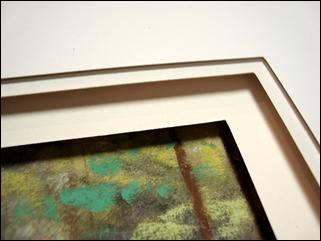 Photo 9
Photo 9
Bottom ½" reveal Bainbridge Antique White #8640 has been lifted away from the pastel with ⅛" AF foam board. The middle Natural White #8656 has a ³⁄₁₆" reveal and is topped with Pearl White #8647. The top two mats are lifted away from the bottom with another ⅛" AF foam spacer.
Decorative mat design applications using multiple window mats and additional spacers may be used to encourage visual depth, but mat colors should be held to soft neutrals. There is a ½" reveal for the bottom Bainbridge Antique White #8640 mat which has been lifted away from the pastel with ⅛" AF foam board. The middle Natural White #8656 has a ³⁄₁₆" reveal and has been topped with Pearl White #8647. The top two mat unit has been lifted away from the bottom with another ⅛" AF foam spacer. Though never touching the art, the bottom mat visually overlaps the pastel about ¼" for sight lines to cover the art edges.
Larson-Juhl Ferrosa Bronze #335556 has a mottled copper finish which emulates the rich colors of the path and the tree (photo 10).
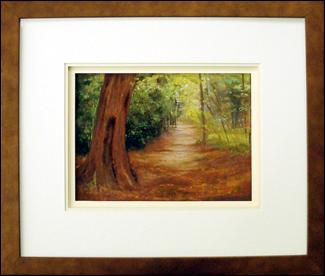 Photo 10
Photo 10
The selected frame moulding should be deep enough to handle all layers including spacers. A Larson-Juhl Ferrosa Bronze #335556 with its mottled copper finish wood frame emulates the rich colors of the path and the tree."A Path In France" is shown courtesy of Redding, CA artist Gwen Walker-Strahan.
The triple mat places the darkest neutral as the inner mat helping draw the eye into the art, while the middle and top mats match worn path and highlights in the pastel.
Glazing
Acrylic sheets are not recommended for pastel because of static electricity. Anti-static cleaners and rags are designed to reduce static charges during cleaning and assembly, not on a day-to-day basis. Because of this static, use of acrylic—even UV and abrasion resistant—should be avoided unless the pastel is unusually large and weight is an issue. In that case the glazing must be placed farther away from the pastel in a much deeper frame.
Fixatives
There are basically two types of fixatives: workable fixative designed to help set layers to prevent smudging, which allows for additional pigment layering, and final fixative which may be applied by the artist at the completion of the work as a shear level of protection. Though protective spray coatings are being promoted in conjunction with assorted commercial panels in lieu of traditional glazed framing practices, fixatives appear to be only short term effective and conservators have unanimously cautioned that such coatings cannot take the place of proper mounting, glazing, and handling of the art. Fixatives may only be applied by the artist and any reputable framer should never agree to apply any fixative to any art.
Ampersand Pastelbord is becoming very popular with artists because of its working surface, but always encourage your artist to glaze their pastel masterpiece. If the original pastel is on a 1-2" cradled Pastelbord the sink mount will just become deeper, but float frames sans glazing are not suitable for pastels.
END
Copyright © 2010 Chris A Paschke
Pastel "A Path In France" is shown courtesy of by Gwen Walker-Strahan.
For more articles on mounting basics look under the mounting section in Articles by Subject.
Additional information on all types of mounting is found in:
The Mounting and Laminating Handbook, Second Edition, 2002,
The Mounting And Laminating Handbook, Third Edition, 2008 and
Creative Mounting, Wrapping, And Laminating, 2000 will teach you everything you need to know about getting the most from your dry mount equipment and materials as an innovative frame designer.
All books are available from Designs Ink Publishing through this website.
Chris A Paschke, CPF GCF
Designs Ink
Designs Ink Publishing
785 Tucker Road, Suite G-183
Tehachapi, CA 93561
P 661-821-2188
chris@designsinkart.com